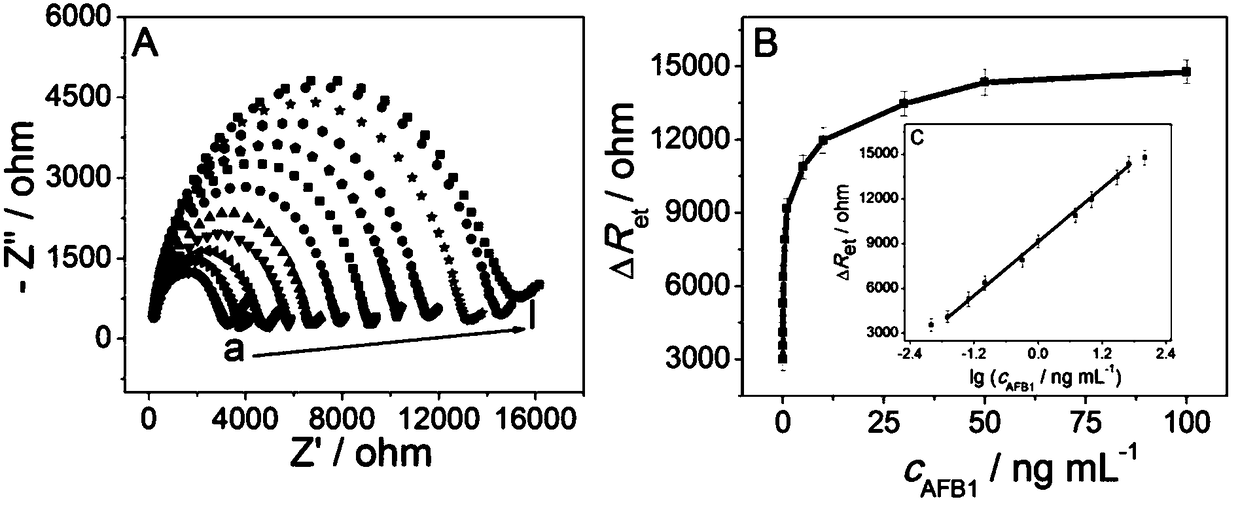Method for preparing label-free portable aptamer sensor for detecting AFB1
A kind of aptamer sensor, portable technology, applied in the direction of instruments, measuring devices, scientific instruments, etc., can solve the problems of limited application of immunoassay methods, complex antibody preparation process, expensive synthesis, etc., to achieve low detection cost, avoid electrode The effect of simple pretreatment procedure and preparation process
- Summary
- Abstract
- Description
- Claims
- Application Information
AI Technical Summary
Problems solved by technology
Method used
Image
Examples
Embodiment 1
[0036] Magnetic nanoparticles Fe 3 o 4 preparation of
[0037] (1) Magnetic nanoparticles Fe 3 o 4 The preparation method of NPs is as follows: 2mmol of FeCl 3 ·6H 2 O was dissolved in a mixed solution of 10mL ethylene glycol (EG) and 10mL ethylene glycol (DEG), and ultrasonically reacted for 30min; then, 20mmol sodium acetate and 2mmol polyethylene glycol (PEG) were added in sequence; the reaction was stirred for 30min, The mixture was moved to a reaction kettle and reacted at 200°C for 3 hours; after the reaction was completed, it was cooled to room temperature, washed several times with ethanol and water, redispersed in 50 mL of ethanol, ultrasonicated for 5 minutes, and set aside.
Embodiment 2
[0039] Magnetic core-shell nanoparticles Fe 3 o 4 Preparation of @Au NPs
[0040] (2) Magnetic core-shell nanoparticles Fe 3 o 4 The preparation method of @Au NPs is: take the Fe in step 1 3 o 4 Magnetic nanoparticle dispersion 40mL, add 400μL propylaminotriethoxysilane (APTS) mechanical stirring reaction at room temperature for 7h, magnetically separate and wash with ethanol several times, redisperse the product in 40mL of water; 4mL of HAuCl 4 Solution (1wt%) was added dropwise to the above dispersion liquid, reflux reaction at 100°C for 30min, then 8mL sodium citrate solution (1wt%) was added dropwise, and after reflux reaction at 100°C for 3h, the obtained product Magnetically separated and washed several times with water, redispersed in 40mL water for later use.
Embodiment 3
[0042] aptamer-modified Fc 3 o 4 @Au nanobiological probe (Fe 3 o 4 Preparation of @Au-apt)
[0043] (3) Aptamer-modified Fc 3 o 4 The preparation method of @Au nanobiological probe is as follows: firstly, take 500 μL of fresh AFB1 (10 μM) nucleic acid aptamer solution activated by tris(2-ethylcarboxy) phosphine hydrochloride (TCEP) and add it to 35 mL Fe 3 o 4 @AuNPs (1mg mL –1 ) in a Tris-HCl buffer solution (50 mM, pH 7.4), and shaken at 37° C. for 1 h. Using an external magnetic field separation method, the magnetron product was repeatedly washed several times with Tris-HCl buffer solution to remove unreacted aptamer. It was redispersed in 35 mL of 2 μM 6-mercaptohexanol (MCH) solution, and reacted for 1 h at 37 ° C to obtain MCH-blocked nanobiological probes (Fe 3 o 4 @Au-apt), washed several times with 10mM Tris-HCl buffer solution to remove unreacted MCH, redispersed it in 35mL Tris-HCl buffer solution (50mM, pH 7.4), and stored at 4°C for later use.
PUM
 Login to View More
Login to View More Abstract
Description
Claims
Application Information
 Login to View More
Login to View More - R&D
- Intellectual Property
- Life Sciences
- Materials
- Tech Scout
- Unparalleled Data Quality
- Higher Quality Content
- 60% Fewer Hallucinations
Browse by: Latest US Patents, China's latest patents, Technical Efficacy Thesaurus, Application Domain, Technology Topic, Popular Technical Reports.
© 2025 PatSnap. All rights reserved.Legal|Privacy policy|Modern Slavery Act Transparency Statement|Sitemap|About US| Contact US: help@patsnap.com

